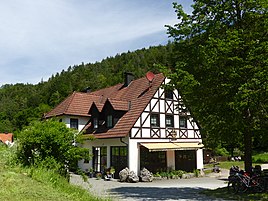Cake mill (Wiesenttal)
|
Cake mill
Wiesenttal market
Coordinates: 49 ° 49 ′ 23 ″ N , 11 ° 17 ′ 0 ″ E
|
|
|---|---|
| Height : | 352 (349-369) m above sea level NHN |
| Residents : | 4 (1987) |
| Postal code : | 91346 |
| Area code : | 09196 |
|
The Wiesenttaler district of Kuchenmühle
|
|
The cake mill is a Franconian wasteland in the lower Aufseßal , which belongs to the Wiesenttal community .
geography
The wilderness in the Wiesentalb is one of 21 officially named districts of the Upper Franconian market Wiesenttal. It is located about three kilometers northeast of the Wiesenttaler municipality seat Muggendorf at an altitude of 352 m above sea level. NHN .
history
The cake mill was first mentioned in documents in 1451 under the name "Chugenmüle". The final word of the place name goes back to the family name "Kuch (e)".
By the end of the 18th century, the mill had cake sovereignty of as Margravate Brandenburg-Bayreuth designated Principality of Bayreuth were under. The dominant village and community rule in the Franconian area was exercised by the caste office in Streitberg . In 1791/1792 the cake mill became Prussian after the last Hohenzollern Margrave Karl Alexander renounced his domains in exchange for an annuity and handed them over to the Kingdom of Prussia , which was ruled by his royal relatives . The kingdom formed the Ansbach-Bayreuth territory administered from Ansbach from these fragmented areas . As part of the main state comparison concluded with the Electorate of Bavaria , the Prussian Kingdom then, among other things, ceded the entire caste office of Streitberg to the Electorate, which also made the cake mill Bavarian.
As a result of the administrative reforms carried out in the Kingdom of Bavaria at the beginning of the 19th century, the cake mill became part of the independent rural community of Albertshof with the second municipal edict in 1818 , to which the two villages Neudorf and Voigendorf also belonged. In the course of the communal territorial reform carried out in Bavaria in the 1970s , the Kuchenmühle together with the Albertshof community became part of the newly formed Wiesenttal community on January 1, 1972. In 1987 the cake mill had four residents.
literature
- Dorothea Fastnacht: Ebermannstadt. Former district of Ebermannstadt . In: Historical book of place names of Bavaria . tape 4 . Commission for Bavarian State History, Munich 2000, ISBN 3-7696-9701-4 .
- Federal Statistical Office (Hrsg.): Historical municipality register for the Federal Republic of Germany. Name, border and key number changes in municipalities, counties and administrative districts from May 27, 1970 to December 31, 1982 . W. Kohlhammer, Stuttgart / Mainz 1983, ISBN 3-17-003263-1 .
Web links
- Bavarian authorities guide for the cake mill , accessed on August 20, 2019
- The cake mill in the BayernAtlas , accessed on August 20, 2019
- The cake mill on a historical map , accessed on August 20, 2019
Individual evidence
- ↑ a b Bavarian State Office for Statistics and Data Processing (Ed.): Official local directory for Bavaria, territorial status: May 25, 1987 . Issue 450 of the articles on Bavaria's statistics. Munich November 1991, DNB 94240937X , p. 304 ( digitized version ). Retrieved August 20, 2019
- ↑ Kuchenmühle in the local database of the Bayerische Landesbibliothek Online . Bavarian State Library, accessed on August 20, 2019.
- ↑ Geographical location of the Kuchenmühle in the Bavaria Atlas , accessed on August 20, 2019
- ^ Dorothea Fastnacht: Ebermannstadt. Former district of Ebermannstadt . In: Historical book of place names of Bavaria . S. 150 .
- ^ Dorothea Fastnacht: Ebermannstadt. Former district of Ebermannstadt . In: Historical book of place names of Bavaria . S. 5-6 .
- ↑ Gertrud Diepolder : Bavarian History Atlas . Ed .: Max Spindler . Bayerischer Schulbuch Verlag, Munich 1969, ISBN 3-7627-0723-5 , p. 31 .
- ^ Johann Kaspar Bundschuh: Geographical Statistical-Topographical Lexicon of Franconia . tape 3 . Verlag der Stettinische Buchhandlung, Ulm 1799, p. 229 ( uni-wuerzburg.de [accessed on August 20, 2019]).
- ↑ Gertrud Diepolder : Bavarian History Atlas . Ed .: Max Spindler . Bayerischer Schulbuch Verlag, Munich 1969, ISBN 3-7627-0723-5 , p. 35 .
- ^ Sigmund Benker, Andreas Kraus (ed.): History of Franconia up to the end of the 18th century . 3. Edition. Beck, Munich 1997, ISBN 3-406-39451-5 , p. 523 .
- ^ Hanns Hubert Hofmann: Between power and law. The Eschenau street district between Prussia, the Electoral Palatinate of Bavaria and the imperial city of Nuremberg (1805/1806) . In: Association for the history of the city of Nuremberg eV (Hrsg.): Messages of the association for the history of the city of Nuremberg . tape 53 . Self-published by the Association for the History of the City of Nuremberg, Nuremberg 1965, p. 13–59 ( digital-sammlungen.de [accessed August 20, 2019]).
- ^ Sigmund Benker, Andreas Kraus (ed.): History of Franconia up to the end of the 18th century . 3. Edition. Beck, Munich 1997, ISBN 3-406-39451-5 , p. 776 .
- ^ Federal Statistical Office (ed.): Historical municipality directory for the Federal Republic of Germany. Name, border and key number changes in municipalities, counties and administrative districts from May 27, 1970 to December 31, 1982 . W. Kohlhammer, Stuttgart / Mainz 1983, ISBN 3-17-003263-1 , p. 681 .



